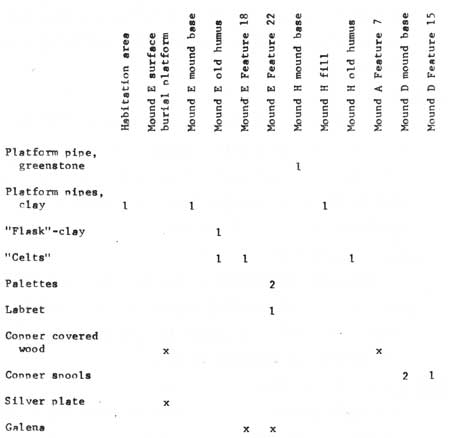|
NATCHEZ TRACE PARKWAY
Excavations at the Pharr Mounds and the Bear Creek Site |

|
OTHER ARTIFACTS AND MATERIALS
The provenience of the artifacts in this category is given in table 7.
TABLE 7.--Provenience of other artifacts and materials,
Pharr Site.

(click on image for a PDF version)
Platform pipes (fig. 22)
Two complete and two fragmentary platform pipes were recovered. One of the complete specimens was of beautifully ground and polished greenstone. The remaining pipes were molded from clay.
Miscellaneous clay artifacts
Three artifacts made from clay were of undetermined function. One was a flattened, flask-shaped artifact (fig. 23c) which had been molded around a small twig or reed, leaving a narrow channel which extended about one-half its length. This unusual object was found in the old humus beneath Mound E.
A small cone-shaped object was also found beneath Mound E. Its base was rough, as if it had been broken off of something. Perhaps this object was a vessel appendage.
The third specimen in this group is an amorphous lump of burned clay which looks as if someone had squeezed it when still plastic and then tossed it in the fire. Perhaps it is the product of a potter's activities. This artifact was found in the black midden area west of Mound H.
"Celts" (fig. 23a-b)
Three flattened, rectangular artifacts are called celts for want of a better term. They are made of a friable, shaly sandstone and would have been totally ineffective as a chopping tool. The edges of all specimens are flat and ground.
Palettes (not illustrated)
Two fragments of tabular sandstone were found which show evidence of grinding on one surface. Two adjacent edges of one specimen appear to have been smoothed and straightened by abrasion as well.
Labret (not illustrated)
This small ground object is made of greenstone. The flattened flange-like base supports a tapering, cylindrical tube with a small hole drilled about half-way into it. This beautiful artifact approximates the size of a .22-caliber cartridge, which it closely resembles.
The third specimen in this group is an amorphous lump of burned clay which looks as if someone had squeezed it when still plastic and then tossed it in the fire. Perhaps it is the product of a potter's activities. This artifact was found in the black midden area west of Mound H.
"Celts" (fig. 23a-b)
Three flattened, rectangular artifacts are called celts for want of a better term. They are made of a friable, shaly sandstone and would have been totally ineffective as a chopping tool. The edges of all specimens are flat and ground.
Palettes (not illustrated)
Two fragments of tabular sandstone were found which show evidence of grinding on one surface. Two adjacent edges of one specimen appear to have been smoothed and straightened by abrasion as well.
Labret (not illustrated)
This small ground object is made of greenstone. The flattened flange-like base supports a tapering, cylindrical tube with a small hole drilled about half-way into it. This beautiful artifact approximates the size of a .22-caliber cartridge, which it closely resembles.
Copper-covered wood (not illustrated)
Two finds of copper-colored wood were recovered. The first consisted of a number of small stained fragments found with one of the cremations in the large pit beneath Mound A. The second is a thin rectangular piece of wood with sheet copper on both sides, taken from the surface of the burial platform at Mound E.
Copper spools (fig. 21)
Three copper spools were recovered from the mound base beneath Mound D. All are of the bicymbal type, of complex construction. Each spool is made of two small, inner flanges and two larger, outer flanges. The space between the two halves was first wound with vegetable fiber, which may have been grass (not string or twine), then filled with clay and, finally, wrapped with more fiber. In two specimens, the outer flange consisted of two sheets of copper hammered together. In the other case, a single, thicker sheet appears to have been used. The outer flanges of one spool (fig. 21c) were covered with a thin sheet of what seems to be silver.
Silver plate (fig. 20)
Several pieces of very thin metal sheets were found together on the burial platform beneath Mound E. Their shape suggests that they might have once jacketed a set of conjoined tubes. Three sheets are elongated, finger-shaped pieces and are bent as if each partially wrapped a single tube. The two remaining fragments are broader and fluted or rippled as if they covered on side of two or three joined cylinders.
Raw materials
Two small pieces of galena were found in Feature 18, a pit dug into the burial platform at Mound E. A larger lump was found in Feature 22, a pit beneath Mound E. Small pieces of unworked mica were recorded in each of the excavated mounds. A large unworked sheet was found in Feature 22.
One bit of negative information is worth mentioning here. On the off-chance that some obsidian might turn up, all flint scrap was saved and examined. No obsidian was found.
| <<< Previous | <<< Contents>>> | Next >>> |
pharr_mounds-bear_creek/sec6-1.htm
Last Updated: 15-May-2008